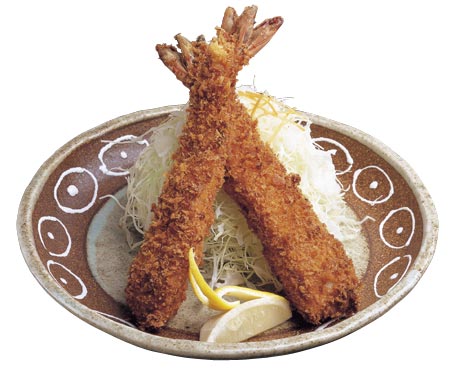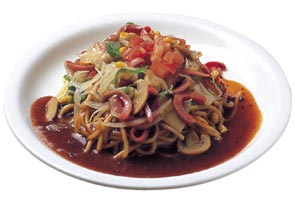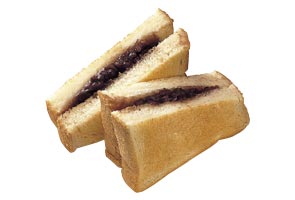| Web Japan > NIPPONIA No.31 > Bon Appetit! |
|
|
|
NIPPONIA No.31 December 15, 2004
|
|
Bon Appetit!
Japanese Culture in the Kitchen
Delectable Tastes of Nagoya
Nagoya's famous rust-colored soybean paste, aka-miso, has a special tang that goes well with meat dishes. And one cannot forget the city's fragrant deep fried shrimp and prawn, and its confectionaries. If you are lucky enough to get to Nagoya,
you will want to try some of these specialties.
|
 |
|
Ebi furai
People in Nagoya are especially fond of prawns, and are convinced that, when choosing them for deep-frying in a breadcrumb coating, the bigger the better. The photo shows the Black Tiger variety (length, about 15 cm). Nipponia thanks the following for their collaboration: Yabaton
|
 |
Hitsumabushi
Rice is mixed with small pieces of grilled eel, and then topped with a generous serving of larger pieces. Served in a container called an o-hitsu, hence the name for this dish (center). The meal is enjoyed in three steps, following this order: first, put some of the rice/eel mixture in a separate rice bowl (lower left) and eat just it; next, toss on a spicy condiment like green onion and/or wasabi (Japanese horseradish paste) and eat some more; then finally, add some more condiments and pour green tea over everything.
Nipponia thanks the following for their collaboration: Ibasho
|
 |
An kake supageti
The recipe started out Italian but was transformed into something original, probably thanks to a Nagoya chef. Vegetables and meat are simmered in a broth, and then potato starch is added to make a thick sauce. The sauce is poured over thick spaghetti. Many Nagoya restaurants specialize in this dish, although the ingredients may vary.
Nipponia thanks the following for their collaboration: Spaghetti House Chao
|
 |
Uiro
Rice flour, sugar and water are kneaded into a paste, and then steamed. Uiro are light and sweet, and have a gooey texture something like mochi rice cake. Made throughout Japan, uiro from the Nagoya area are especially famous. They are ideal as a refined sweet for the tea ceremony,
so it is natural that Nagoya, where the ceremony was widely practiced after the 16th century, has many traditional confectionary stores. The white kind is flavored with sugar only, the pink with a hint of cherry blossom, and the green with green tea powder.
Nipponia thanks the following for their collaboration: Aoyagi Souhonke
|
 |
Ogura tosuto
A somewhat unusual item that is sure to be on the menus of kissaten (coffee shops), which attract many Nagoya folk. Made by toasting bread, spreading on butter, and then making a sandwich with sweet adzuki bean paste in the middle.
|
|
||||||
|
||||||
|